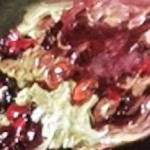 Detail from Painting a Day Series Painting #4 copyright Margret E. Short 2010
Detail from Painting a Day Series Painting #4 copyright Margret E. Short 2010
Over the recent months I have been experimenting with a new medium purchased at Natural Pigments, called Velazquez Medium. It is completely different from the more commonly used liquid mediums. This one is made with finely ground calcite in linseed oil, which extends the paint without altering its consistency. It also allows greater control over tints without adding whites.
Painting with this medium promotes a much more sculptural technique, rather than rendering or refining the surface to an all-over smooth appearance. It will more easily achieve a lively but soft impasto with a painterly effect in the areas of focus. I find this to be far more beautiful because of the wide variety of textures across the canvas, as you can see in the detail of the pomegranate seeds above.
Mix it right into your paint. Scooping the paint from the palette in a down then up (like an airplane’s nose landing and immediately taking off again) motion works much better than just swiping the paint across the palette’s surface. This way you have a whole gob of paint on the end of the brush to deposit on the painting. Then scoop up another piece and deposit it again. Of course, in the areas where you do not want the texture, say, in the shadow areas, then use smaller amounts of paint with a little added linseed.
Have any of you tried this medium? David Rourke stated on his blog that he has used it and even made his own. Would love to hear other results any of you have had.

Margret, excellent work on the pomegranate. You’ve got the essence captured in lovely painterly skills. Wish I could see it in a larger view.
I am very impressed with your ongoing alchemical experiments. The NP Velazquez medium and all the putty based mediums are worth exploring. I’m doing the same. The simplicity of it is intriguing and leads to a lot of speculation on how many old masters worked, especially on very large pieces. I love how many hues are enriched without a resin component and without the graying effect of white, which can still be reserved for impasto highlights. I feel a loss of some control, but maybe that’s good for me.
Hello Sander, How nice to hear from you. So glad to know you have experimented with this interesting medium. Like you, I have been quite impressed with the varied appearance of the applications, especially that it creates tints without adding whites until almost the very last stroke.
You are correct about the simplicity, and one important attribute is absolutely no odor due to the absence of solvents. I have not yet made my own Velazquez medium but have it on my schedule. The addition of egg would be another interesting experiment also. Have you tried it with egg? I hope to hear from other painters who have used this.
Till next time,
Margret
PS I posted a larger image as you requested.
Hello Margret,
I’ve been painting with linseed oil and calcite for years, ever since reading that chemical analysis finds calcite in Velazquez’s painting surfaces. I like the body, but I don’t mix it so that it is too thick.
–Lisa